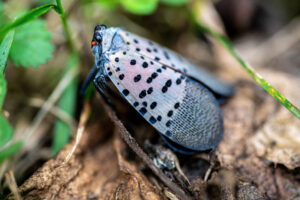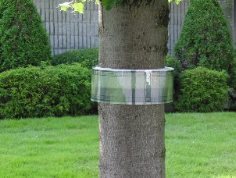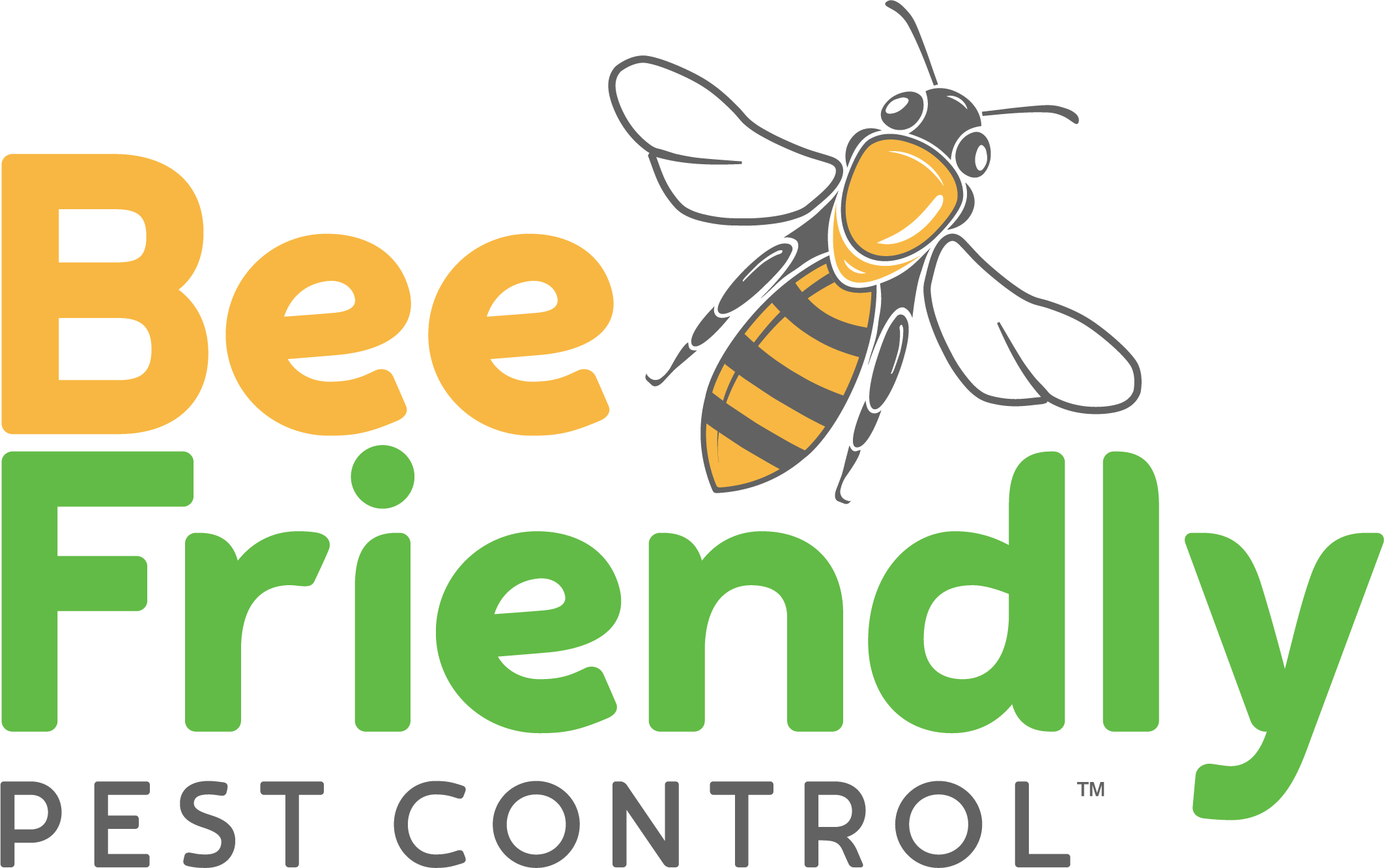The spotted lanternfly is an invasive species native to Southeast Asia that threatens many types of plants in the US because of its feeding habits. The invading insect first appeared in Pennsylvania but quickly spread to the surrounding states, causing damage to numerous host plants.
Our pest control experts can help mitigate the spotted lanternfly populations around your home without harming the vegetation, people, or animals – including bees!
What Is a Spotted Lanternfly?
 Despite its name, the spotted lanternfly isn’t a fly but a planthopper, similar to a cicada or aphid. Spotted lanternflies feed on the sap of at least 70 species of plants, and their favorites include hardwood trees, hops, grapes, and fruit trees.
Despite its name, the spotted lanternfly isn’t a fly but a planthopper, similar to a cicada or aphid. Spotted lanternflies feed on the sap of at least 70 species of plants, and their favorites include hardwood trees, hops, grapes, and fruit trees.
Spotted lanternflies are parasites that feed on host plants, changing their eating habits as they mature from nymphs to adults. Adult spotted lanternflies prefer the tree species known as tree of heaven, but nymphs commonly feed on a wide range of plants, including fruit trees and grape vines.
What Kind of Damage Do Spotted Lanternflies Do?
With massive populations spanning several states in the Northeastern US, spotted lanternflies can cause extensive damage to plants that affects industries like logging, fruit, and wine. In response, counties in the affected states have implemented quarantines to slow the spread of the insects. Since the first sighting in 2014, the list of quarantined counties has continued to grow.
You can recognize plants with spotted lanternfly damage by looking for these common signs:
- Sticky, brown egg masses
- Streaks of sap on tree bark
- Layers of honeydew
- Sooty mold
- Increased number of bees and wasps
If you have a severe infestation, the spotted lanternflies might excrete so much honeydew that it rains down from the trees or plants. Over time, honeydew can leave behind a black sooty mold that stands out on affected plants. The sweet substance can also attract a large number of bees and wasps to the area.
The Life-Cycle of a Spotted Lanternfly
These insects lay clusters of eggs that look like masses of brown seeds that are around an inch long. The eggs have a coating of thick secretions that helps them stick to flat surfaces. When the eggs hatch in late spring, the spotted lanternflies start as nymphs and go through four stages of life.
During the four instar stages, the nymphs climb trees to feed on the sap and develop into adults by mid-summer. The adult spotted lanternflies mate and lay eggs in late summer and early fall. While the adults die in winter, the eggs survive because of the protective layer of secretions around them.
How To Identify a Spotted Lanternfly
Recently hatched spotted lanternflies, known as nymphs, are black with white spots and measureabout a fourth of an inch long. As the nymphs grow, they become around a half of an inch long and develop some red coloring.
Adult spotted lanternflies have brown forewings with black spots and red hindwings with black spots, and they’re about an inch long fully grown. The red wings are only visible when the insects open their brown-colored wings on top.
Prevention and Control of Spotted Lanternflies
Spotted lanternflies are a threat to big businesses, but they also threaten your ability to peacefully enjoy the outdoor space around your home. Our pest control experts at Bee Friendly Pest Control have experience eradicating these invading insects without using harmful chemicals.
If you notice signs of spotted lanternflies, give us a buzz right away so we can provide a spotted lanternfly treatment before the population gets out of hand!
Egg Scraping
An essential step in controlling the spotted lanternfly population is getting rid of the eggs, which you can do yourself if you notice egg clusters between pest control appointments. You can typically find eggs on various outdoor surface, including:
- Trees
- Furniture
- Picnic tables
- Playground equipment
- Vehicles
Using a tool with a flat edge, scrape the eggs off the surface and seal them in a plastic bag or container with hand sanitizer or rubbing alcohol for disposal.
Spotted Lanternfly Treatment
Besides using a treatment to control spotted lanternflies, pest control professionals can curb their numbers by removing their favorite plants and using tree barriers to deter nymphs from feeding.
ASK ABOUT OUR Bee Friendly Tree Bands for additional protection against these pesky invaders.
Get a Free Tree Band With Seasonal Treatment Plan ($50 value)

The Importance of Eliminating Spotted Lanternflies
Protecting the Environment
As mentioned previously, eliminating spotted lanternflies is crucial for protecting the environment. These invasive pests pose a significant threat to various ecosystems and agricultural crops. Spotted lanternflies, scientifically known as Lycorma delicatula, primarily feed on the sap of host trees, including hardwood trees, fruit trees, and ornamental trees.
This feeding weakens the trees, making them more susceptible to diseases and reducing their overall health. Spotted lanternfly infestations can lead to the decline of important tree species, disrupting local ecosystems. To prevent the spread of this invasive pest, spotted lanternfly control measures, including the use of spotted lanternfly exterminators and the removal of spotted lanternfly egg masses, are essential.
Preventing More Spotted Lanternfly Eggs
In addition to their threat to trees, eliminating spotted lanternflies is important to prevent them from laying more eggs. During their life cycle, spotted lanternfly adults lay their egg masses on various surfaces, such as tree trunks, outdoor furniture, and other plants. Each egg mass contains dozens of lanternfly eggs. If these egg masses are not removed, they will hatch into nymphs in the spring, leading to a surge in spotted lanternfly populations.
To prevent this from happening, it’s important to scrape and destroy spotted lanternfly egg masses in the late fall and early winter before they can hatch — thus interrupting the spotted lanternfly’s life cycle, reducing their numbers, and lowering the chances of a spotted lanternfly infestation in your area.
When You Need an Experienced Spotted Lanternfly Exterminator in the Following Areas, Give Us a Call:
- Philadelphia Suburbs
- Camden County
- Gloucester County
- Burlington County
- Collingswood
- Voorhees
- Deptford
- Mount Laurel
- Burlington
- Cherry Hill
- Haddonfield
- Medford
ASK ABOUT OUR Bee Friendly Tree Bands for additional protection against these pesky invaders.
Protecting Your Home From Spotted Lanternflies With Safe, Organic Pest Control
At Bee Friendly Pest Control, we don’t use toxic chemicals to keep your home safe from pests like spotted lanternflies — instead, we take advantage of natural ingredients, such as rosemary, thyme, garlic, and clove, that are safe to use around animals, crops, and bees.
Call us at 1-866-996-4785 to get a free quote for spotted lanternfly treatment!
FAQ
When is the spotted lanternfly season?
You can see adult spotted lanternflies from July to December. Females lay eggs in late summer and early fall, typically starting in September. The eggs hatch in late spring, usually, May or April, and the nymphs feed throughout the summer.
How do you prevent spotted lanternflies?
Spotted lanternflies reproduce in large numbers, so stopping the spread is the most important step. Checking your property for eggs and disposing of them properly can cut down on the population.
You can also prevent infestations by removing the plants that spotted lanternflies like to eat from your property.
Where in the US are spotted lanternflies?
Spotted lanternflies appeared in Pennsylvania in 2014 but have spread as far as Indiana, Virginia, and Massachusetts. The largest populations are in southern Pennsylvania, Maryland, and New Jersey.
Every county in New Jersey is under quarantine, requiring businesses to take extra precautions before sending materials to other locations.
What plants do spotted lanternflies eat?
Spotted lanternflies eat over 70 species of plant, including popular tree species such as:
Tree of heaven
Willow
Maple
Fruit (apple, plums, peaches, etc.),
Grape vines
Pine
Birch
Black walnut
Our spotted lanternfly treatment can help prevent damage to these plants without harming plants and animals.
Where did spotted lanternflies come from?
Spotted lanternflies originate from China and were first detected in the United States in Eastern Pennsylvania in 2014. They likely arrived in shipments of goods, as lanternfly nymphs and adult spotted lanternflies can hitch a ride on various surfaces. Since then, they have spread to several states, including New Jersey, West Virginia, and beyond.
These invasive pests have very few natural predators, which makes controlling spotted lanternflies a significant challenge. Implementing spotted lanternfly treatments, such as tree banding, soil drenches, and systemic insecticides, can help reduce their impact on local ecosystems and agricultural areas.
